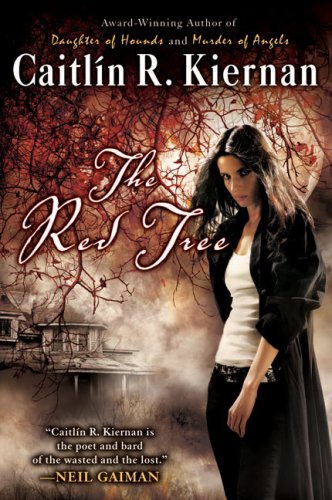
Caitlín R. Kiernan’s The Red Tree is a dizzying weird gothic novel that chronicles the final months of a writer named Sarah Crowe as she grieves for her dead girlfriend, wrestles with writer’s block and tries to unravel the dark mysteries behind the legends surrounding an ancient oak tree growing near the farmhouse she’s rented for the summer. While it evokes echoes of Robert Chambers and H.P. Lovecraft in its theme of madness-inducing manuscripts and in elements of the prose style, the psychological horror in it reminds me of The Yellow Wallpaper and The Turn of the Screw in the best possible way.
There’s a lot I really admire about this novel. For instance, some of the descriptions are amazing: “And she just sat there, smoking and watching me with those fucking gray-green eyes of hers, eyes like lichen clinging to boulders on Rocky Mountain tundra or alpine meadows, like something unpleasant growing in the back of the fridge, eyes that were cold and hard, but very much alive.” (Kiernan 28)
But the thing that struck me most about the novel was its narrative bones. While on the surface it seems to have a winding, random story like a mass of ivy or tangle of deadfall branches, it’s actually got a really interesting nested epistolary structure, like a set of nightmarishly-painted Matryoshka dolls.
(Spoilers follow!)
The whole novel is framed by a first-person preface by Sharon D. Halpern, the main character’s fictional editor. She tells the reader that after she took on the job of editing the memoir Sarah wrote before her death, she visited the farm for herself to see the red oak and insists that the story is not hers to tell. (A reader who’s finished the novel and re-reads the preface can pretty safely assume that Halpern will not escape unscathed from her visit to the tree, because a sensible person would have stayed far away from it, and so Halpern has likely been caught in its snare simply by reading Sarah’s manuscript.)
The second narrative layer is offered by the fictional journal entries of Sarah herself as she writes the bulk of the narrative. However, we soon get a third layer in the form of Sarah’s excerpts from a manuscript she finds in a box in the basement of the house: a rambling, unfinished nonfiction book about the legends of the Red Oak written by Dr. Charles Harvey, a professor who also rented the farmhouse and who committed suicide there a few years before Sarah’s arrival. And through Harvey’s manuscript, we get a fourth layer in the form of the stories and eyewitness accounts that the professor has transcribed.
It’s a clever and complicated framework; it’s a challenge to map all the stories-within-stories, even though it all feels completely organic on the page. I’ve written only one epistolary story but the structure I employed was an uncomplicated, linear set of emails. I enjoyed writing that and want to try another epistolary narrative sometime. If I decide to try for a more ambitious story construction, I’m going to keep The Red Tree on hand for inspiration.
Works Cited
Kiernan, Caitlín R. The Red Tree. New York: Roc, 2009. Print.
Leave a Reply
You must be logged in to post a comment.